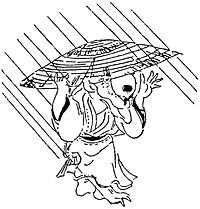Amefurikozō


Amefurikozō (
Classics
[edit]In the Konjaku Gazu Zoku Hyakki it wears a Japanese umbrella with its central pole missing, and it is depicted possessing a paper lantern. In the explanatory text, it says, "speaking of the rain god Ushi, there is the amefurikozō, who works as its jidō (
Since Ushi (
In the kibyōshi of the Edo period, just like the popular kibyōshi character tōfu-kozō, they appear as yōkai that take on the role of servants.[2] In the kibyōshi "Gozonji no Bakemono (
Modern
[edit]According to yōkai literature published after the Showa and Heisei eras, there are the theories that if you steal the umbrella from him and wear it, one would not be able to take it off,[4] and the theory that they make it shower and delight at seeing people get troubled.[5] According to the explanation at Mizuki Shigeru Road in Sakaiminato, Tottori Prefecture, the amefurikozō would be the one with the role of adjusting rain, something that is greatly related to the work and life of all living things.[6]
In Norio Yamada's writing titled "Tōhoku Kaidan no Tabi", in the part titled "Amefurikozō", there is a story where at Sennin Pass in Kamihei District, Iwate Prefecture, a fox (kitsune) requested to an amefurikozō, "I shall be performing a fox's wedding (kitsune no yomeiri), so please make the rain fall," and when the kozō waved a paper lantern that it has making the rain suddenly fall, and during that time the fox's wedding was performed.[7]
See also
[edit]References
[edit]- ^ a b
多田 克己 (1999). "絵解 き画図 百鬼夜行 の妖怪 ". In郡司 聡 他 編 (ed.).季刊 怪 . カドカワムック. Vol.第 伍 号 .角川書店 . pp. 300–301頁 . ISBN 978-4-04-883575-6. - ^
飯島 吉晴 (2011). "豆腐 小僧 の周辺 小 さ子 神 の系譜 ". In郡司 聡 他 編 (ed.).怪 . カドカワムック. Vol. 0032.角川書店 . p. 167頁 . ISBN 978-4-04-885094-0. - ^
延広 真治 編 (2000).江戸 の文事 . ぺりかん社 . pp. 177–178頁 . ISBN 978-4-8315-0937-6. - ^
少年 社 ・中村 友紀 夫 ・武田 えり子 編 (1999).妖怪 の本 異 界 の闇 に蠢 く百鬼夜行 の伝説 . New sight mook.学習 研究 社 . p. 108頁 . ISBN 978-4-05-602048-9. - ^
草野 巧 ・戸部 民夫 (1994).日本 妖怪 博物館 .新 紀元 社 . p. 155頁 . ISBN 978-4-88317-240-5. - ^ "
雨降 り小僧 (あめふりこぞう)".境港 市 . Archived from the original on 2011-05-27. Retrieved 2011-05-17. - ^
山田野 理 夫 (1974).東北 怪談 の旅 .自由 国民 社 . p. 178頁 .
